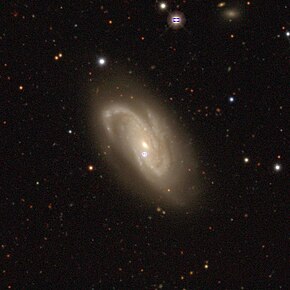| NGC 1616 | |
|---|---|
 A Legacy Surveys image of NGC 1616 | |
| Observation data (J2000 epoch) | |
| Constellation | Caelum |
| Right ascension | 04h 32m 41.80s[1] |
| Declination | −43° 42′ 55.00″[1] |
| Redshift | 0.01488±0.000033[1] |
| Distance | 213 Mly (65.58 Mpc)[1] |
| Apparent magnitude (V) | 12.5[1] |
| Characteristics | |
| Type | SAB(rs)bc pec?[1] |
| Size | 116,000 ly |
| Apparent size (V) | 1.905′ × 1′[1] |
| Notable features | N/A |
| Other designations | |
| ESO 251-10,[1] PGC 15479,[1] LEDA 15479,[1] MCG -07-10-013[1] | |
NGC 1616 is an intermediate spiral galaxy located around 213 million light-years away in the constellation Caelum.[2] NGC 1616 was discovered on October 24th, 1835 by the astronomer John Herschel, and its diameter is 116,000 light-years across.[1][3] NGC 1616 is not known to have much star-formation, and it is not known to have an active galactic nucleus.[4][1]
References
[edit]- ^ a b c d e f g h i j k l m "By Name | NASA/IPAC Extragalactic Database". ned.ipac.caltech.edu. Retrieved 2024-04-01.
- ^ "NGC 1616 - Intermediate Spiral Galaxy in Caelum | TheSkyLive.com". theskylive.com. Retrieved 2024-04-01.
- ^ "NGC 1616 - Galaxy - SKY-MAP". www.wikisky.org. Retrieved 2024-04-01.
- ^ "New General Catalog Objects: NGC 1600 - 1649". cseligman.com. Retrieved 2024-04-01.
External links
[edit] Media related to NGC 1616 at Wikimedia Commons
Media related to NGC 1616 at Wikimedia Commons
Well, that’s interesting to know that Psilotum nudum are known as whisk ferns. Psilotum nudum is the commoner species of the two. While the P. flaccidum is a rare species and is found in the tropical islands. Both the species are usually epiphytic in habit and grow upon tree ferns. These species may also be terrestrial and grow in humus or in the crevices of the rocks.
View the detailed Guide of Psilotum nudum: Detailed Study Of Psilotum Nudum (Whisk Fern), Classification, Anatomy, Reproduction